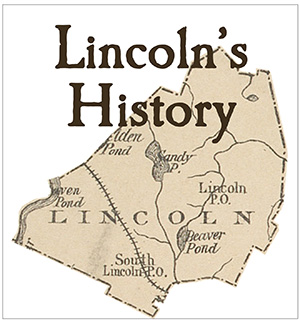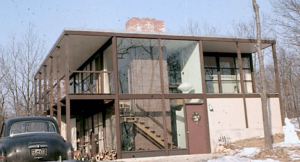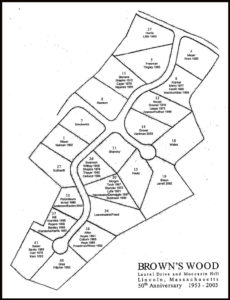 By Don Hafner
By Don Hafner
(Editor’s note: Brown’s Wood was designated as Lincoln’s newest Historic District in 2018 to recognize its many examples of Modern architecture.)
Did you know… that Lincoln has a neighborhood originally built as a utopian vision?
That neighborhood is Brown’s Wood, built on a woodlot once owned by Deacon Benjamin Brown (1681-1753). Brown’s Wood began in 1953 as a utopian, cooperative community envisioned by Ranny and Ann Gras, along with a few MIT colleagues and others attracted by MIT bulletin‑board notices and FM radio ads. They invested $3,000 each for the common expenses of buying the raw, rocky woodland and for initial development and infrastructure of the subdivision along the new roads named Laurel Drive and Moccasin Hill Road.
Two lots were initially designated as common land, intended for community recreation. The first 23 houses were designed, built, and financed by each family under the general supervision of the group, which also collectively oversaw the road construction and town approvals. The group agreed that all the houses would be contemporary style. Traditional colonials, capes, or ranches were not permitted. A few residents tackled interior work themselves, and many of the houses’ interiors were not completely finished for years.
Decisions in the Brown’s Wood community were made by consensus, such as naming the roads after local wildflowers, rejecting a proposal for bulk‑buying of staples like toilet paper or milk, and rejecting a swimming pool and tennis court for the community land. At one point, to avoid the mounting expenses for snowplowing and road maintenance, the residents agreed to sell one of the common lots to finance enough improvements in the roads so the town would accept them as town streets. The general sense of sharing and cooperation continued, including regular meetings to discuss neighborhood concerns, common ownership of chainsaws and other equipment, and a baby-sitting cooperative.

The Gras family (Brown’s Wood founders Ranny and Ann Gras and their sons Seaton and Adrian) in a newspaper photo upon their return in 1975 from their six-year round-the-world sailing trip.
There were lots of kids in the neighborhood. One year, an entire school bus was filled with the Brown’s Wood elementary school children who waited at the intersection of the two roads.
In 1964, the other common lot was sold to purchase shares in the Valley Pond, which were then legally tied to each of the house lots. The pond was a separate project created by the efforts of several Brown’s Wood families (a story for another time). Although the formal Brown’s Wood organization was then dissolved, many residents had strong community spirit and went on to participate actively in the town government and League of Women Voters.
Current and former residents celebrated Brown’s Wood’s 35th anniversary in 1988, and commemorated it with a group memoir and a pear tree planted at the intersection of the two roads to honor Ann and Ranny Gras. Today, many of the houses look much as they did when built, although some have been enlarged. Meandering paths still lead to the shores of Valley Pond, and Brown’s Wood is still a great place to raise children.

One of the Brown’s Wood houses when it was completed in the 1950s, highlighting the neighborhood’s then-revolutionary Modern architecture.
This article is based on an earlier history of Brown’s Wood written by one of the original “settlers,” Ruth Johnstone Wales (1927-2018). It has been edited and updated by Esther and Peter Braun, also early “settlers.” Esther Braun taught in the Lincoln public schools, and her son Peter was one of the kids in the Brown’s Wood neighborhood and babysat for the Wales family.
“Lincoln’s History” is a biweekly column about aspects of Lincoln’s past by members of the Lincoln Historical Society.

Readers of The Squirrel should note that this wonderful article about Lincoln’s history was the work of Esther and Peter Braun, who edited an earlier article by Ruth Johnstone Wales. All credit goes to them. I merely served as the coordinator for the Lincoln Historical Society.
Don Hafner